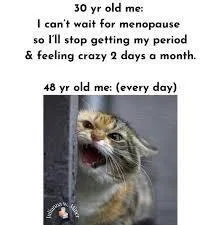

Moon Essence™ Blog
Blog

Perimenopause Explained: How to Recognize the First Signs and What to Expect

If you’ve started to notice changes in your menstrual cycle, mood, or sleep that you can’t quite explain, you might be questioning whether or not you are entering perimenopause. Perimenopause is a natural phase of life and doesn’t have to be the harrowing adventure of memes and TikTok videos.
Often beginning years before menopause itself, perimenopause is the body’s gradual transition toward the end of reproductive years.
Understanding what’s happening inside your body can make this stage feel less confusing and much more manageable. In this guide, I’ll walk you through what perimenopause is, when to expect it, the first signs to watch for, and ways to support yourself through the journey.
What Is Perimenopause?
Perimenopause, which literally means “around menopause,” is the time when your hormones begin to shift, and your ovaries slowly start producing less estrogen and progesterone. This stage can last several years before you reach menopause. Perimenopause is the journey.
Many people use perimenopause and menopause interchangeably which can make things confusing but menopause, by definition, is the one day when you’ve gone 12 months without a menstrual period. The next morning you wake up - you are post menopausal. Wild, right?
While menopause marks a single moment in time, perimenopause is the entire lead-up to it. Hormonal fluctuations during this time are responsible for the physical and emotional symptoms many women experience.
When Does Perimenopause Usually Start?
Most women begin perimenopause in their late 30s to mid-40s, but it can start earlier or later. According to Traditional Chinese Medicine (TCM), shifts in Qi (your vital energy) can start a couple years on either side of 35 depending on how you care for yourself. For most women, the more obvious signs start closer to 40. In TCM these years are known as the Metal Years.
Factors that can influence when it begins include:
Genetics – If your mother experienced early or late menopause, you may follow a similar timeline.
Lifestyle – High stress, smoking, and poor nutrition can sometimes bring symptoms on earlier.
Medical history – Certain health conditions, surgeries, or treatments may affect hormone balance.
It’s also possible to have early perimenopause before age 40, though this is less common.
Early Signs of Perimenopause
TCM understands that women’s bodies change in 7 year cycles. The first benchmark is 35 when your Qi, or your vital energy, begins to change. This could look like changes in stamina. You might notice you can’t pull an “all nighter” like you used to or work at the same pace. Your body starts extending the invitation to create more intentional balance between work and rest.
The second big benchmark is 42 when the yin begins to decline. This is where we start feeling more dry (think: hair, skin, personal moisture, feeling thirst.) This is where the road to menopause starts to feel more present.
The first signs are often subtle — changes you might easily chalk up to stress, busy schedules, or aging.
Common early indicators in the late 30s and early 40s include:
Irregular menstrual cycles – Shorter, longer, heavier, or lighter than your usual.
Changes in menstrual flow – More clots, spotting between periods, or unpredictable timing.
New PMS-like symptoms – Bloating, mood swings, and headaches may appear or intensify.
Breast tenderness – Soreness or swelling at unexpected times in your cycle.
Sleep disruptions – Trouble falling or staying asleep.
These changes are your body’s way of signaling that your hormone levels are beginning to shift. The shift is normal. What isn’t normal is the pace of modern life and the demands of it. This creates the right environment for symptoms to be more disruptive than they have been in previous generations.
Common Symptoms You Might Notice
As perimenopause progresses, symptoms often become more noticeable. The menopausal transition is typically between 49-55 with the average age in the United States being 51. Often closer to 49 it is common to see some of the following symptoms arise.
Physical symptoms may include:
Hot flashes – Sudden feelings of heat, often with flushing and sweating.
Night sweats – Hot flashes that occur during sleep.
Vaginal dryness – Caused by lower estrogen levels affecting tissue elasticity.
Weight changes – Particularly around the abdomen.
Joint aches – Stiffness or soreness without injury.
Many women start questioning depression, anxiety and rage during this timeframe. Your brain has lots of estrogen receptors and as the composition of the symphony of hormones in your body changes it is very common for emotions to feel bigger as well.
Emotional and mental changes can include:
Mood swings or irritability.
Anxiety or depression.
Difficulty concentrating or memory lapses (“brain fog”).
Not every woman will experience all these symptoms, and their intensity can vary widely. Stress and diet can heavily influence the experience with these symptoms.
How Long Does Perimenopause Last?
On average, perimenopause lasts 7-10 years, but some women move through it in just a couple of years, while others experience symptoms for more than a decade.
You officially reach menopause when:
You’ve gone 12 consecutive months without a period.
Other causes for the absence of menstruation (such as pregnancy or thyroid disorders) have been ruled out.
Supporting Your Body During Perimenopause
While perimenopause is a natural transition, there’s plenty you can do to ease symptoms and maintain your well-being:
1. Focus on Nutrition
Eat a balanced diet rich in vegetables, fruits, whole grains, lean proteins, and healthy fats.
Include foods with phytoestrogens (like flax seeds and lentils) to help support hormone balance.
Stay hydrated — water helps regulate temperature and energy levels. Add a little himalayan sea salt for electrolyte balance.
Traditional Chinese Medicine loves Yin supportive foods for this time frame because they help the body to hold moisture and provide the building blocks needed during this time. These are things like dark leafy greens, bone broth, kidney beans, black beans, artichokes and eggs.
This is not the time for the newest fad diet. Your body is already doing a big job with these hormonal changes. Extremes in macros and overall caloric intake cause unhelpful stress on the body and in many cases are counterproductive to your goals.
2. Move Your Body
Aim for regular exercise that combines strength training, cardiovascular movement, and flexibility work.
Physical activity supports bone health, heart health, and mood stability.
Gone are the days of an hour of cardio at the gym. Many women fall into this trap because we have been led to believe “calories in - calories out” but in perimenopause this couldn’t be further from the truth. Remember what I said about stress? Heavy cardio falls into that category. You will accomplish more with 2-3 days of weight training a week than you ever will spending an hour on an elliptical.
3. Prioritize Rest and Stress Management
Practice mindfulness, meditation, or yoga to calm your nervous system.
Set a consistent sleep schedule and create a bedtime routine.
4. Consider Natural Support
Herbal remedies such as black cohosh, red clover, or evening primrose oil may help — but always check with a qualified herbalist first.
Acupuncture, Acutonics, pelvic steaming, and sound healing can also support emotional and hormonal balance.
5. Talk to Your Care Team
They can help you rule out other conditions, discuss treatment options, and create a personalized plan for your symptoms. Your care team can be a blend of traditional doctors, herbalists, chiropractors, energy workers - everyone who you support your body with. Everyone has different tools in their toolkit to put together the picture of why you feel the way you do and what can be done to create more ease.
6. Self Reflection
As your walking through this transition you are transforming into a different version of you - physically, mentally and spiritually. Create space to reflect on what still feels aligned, what doesn’t, what excites you (maybe you have new interests or want to seek out new hobbies!) and make a list of these.
This transition feels unnerving for some because you are stepping into a new chapter of your life and you feel differently about everything! Allowing yourself to sit with what you want and what no longer serves you can be a powerful tool in reducing how severe your symptoms are during this phase of your life. If you want help with this - join us for Rebel Remembered and we will walk through this journey of discovery together.
Conclusion
Perimenopause is a powerful life stage — a natural shift that marks the body’s movement into a new rhythm. While the symptoms can sometimes feel overwhelming, understanding what’s happening is the first step in feeling more grounded and in control.
By listening to your body, making supportive lifestyle choices, and seeking guidance when needed, you can move through perimenopause with clarity, confidence, and care.
For more resources about perimenopause listen to the award winning Reproductive Rebel podcast and join us for Rooted Rising: Perimenopause where we take a closer look at the changes you can expect and how to care for your dynamic body.
